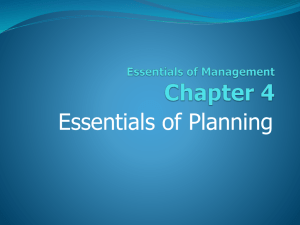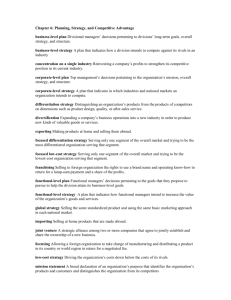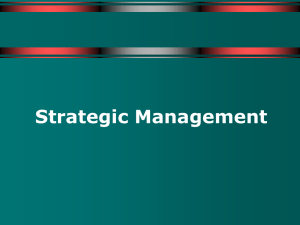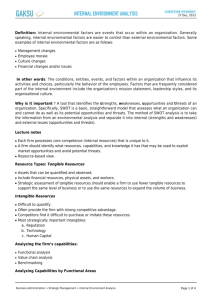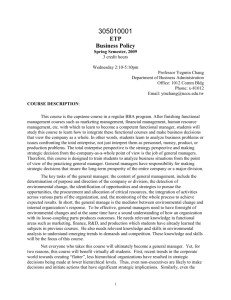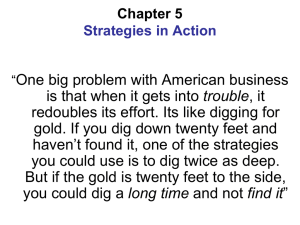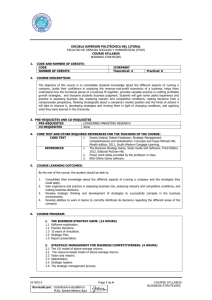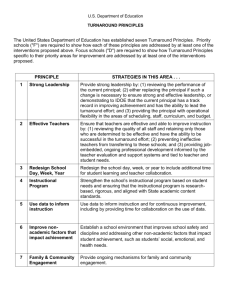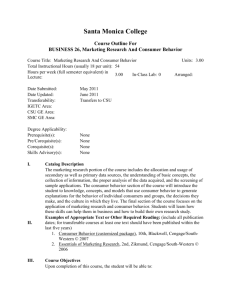the strategic and operational planning process
advertisement
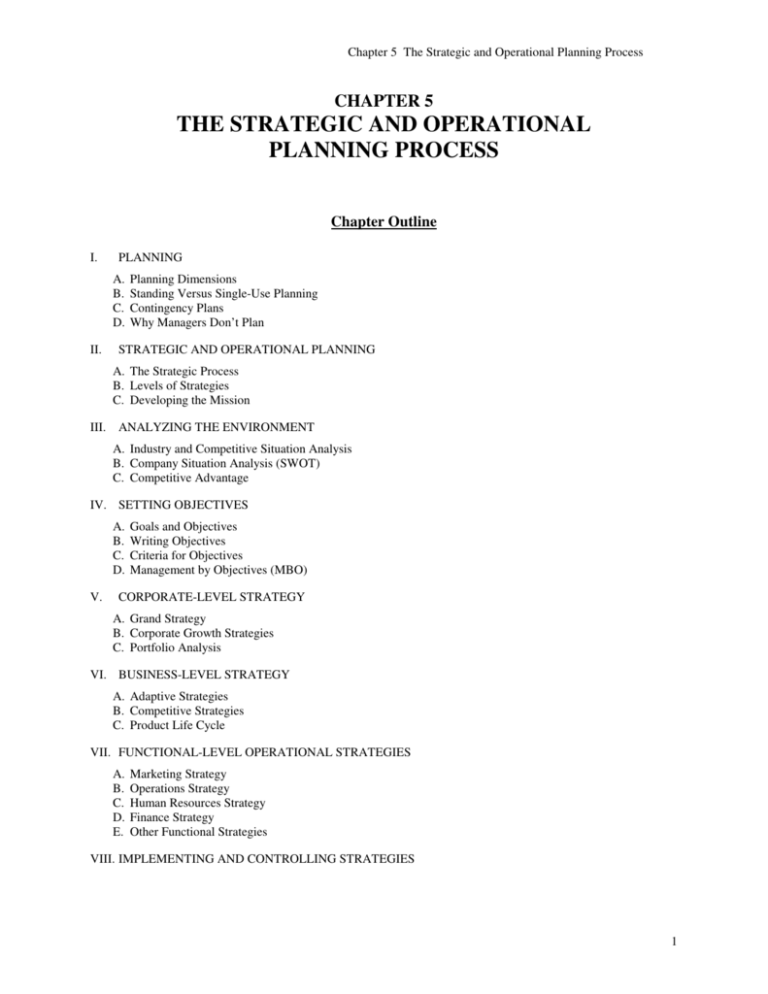
Chapter 5 The Strategic and Operational Planning Process CHAPTER 5 THE STRATEGIC AND OPERATIONAL PLANNING PROCESS Chapter Outline I. PLANNING A. B. C. D. II. Planning Dimensions Standing Versus Single-Use Planning Contingency Plans Why Managers Don’t Plan STRATEGIC AND OPERATIONAL PLANNING A. The Strategic Process B. Levels of Strategies C. Developing the Mission III. ANALYZING THE ENVIRONMENT A. Industry and Competitive Situation Analysis B. Company Situation Analysis (SWOT) C. Competitive Advantage IV. SETTING OBJECTIVES A. B. C. D. V. Goals and Objectives Writing Objectives Criteria for Objectives Management by Objectives (MBO) CORPORATE-LEVEL STRATEGY A. Grand Strategy B. Corporate Growth Strategies C. Portfolio Analysis VI. BUSINESS-LEVEL STRATEGY A. Adaptive Strategies B. Competitive Strategies C. Product Life Cycle VII. FUNCTIONAL-LEVEL OPERATIONAL STRATEGIES A. B. C. D. E. Marketing Strategy Operations Strategy Human Resources Strategy Finance Strategy Other Functional Strategies VIII. IMPLEMENTING AND CONTROLLING STRATEGIES 1 Lecture Outline I. PLANNING A. Planning Dimensions 1. 2. 3. 4. 5. Management level. The level that develop the plan. Type of plan Strategic or operational. Scope of the plan covered. The plan can be broad in scope, such as for the entire organization or for a business unit, or it can be narrow such as for a functional department or for just a part of department or even for one employee. Time. Long or short range. Repetitiveness. Single-use or standing plan. B. Standing Versus Single-Use Plans 1. Standing Plans: Standing plans include policies, procedures, and rules developed for handling repetitive situations. Their purpose is to guide employees'actions in decision-making. Policies provide general guidelines to be followed when making decisions. Procedures are a sequence of actions to be followed in order to achieve an objective. Rules state exactly what should or should not be done. Single-Use Plans: Single-use plans include programs and budgets developed for handling nonrepetitive situations. A program describes a set of activities and is designed to accomplish an objective over a specified time period. Programs are not meant to exist over the life of the organization. A budget is the funds allocated to operate a department for a fixed period of time. Many people fear budgets because they have low math or accounting skills. In reality, most budgets require planning skills rather than mathematical skills. When developed a budge it is a planning tool; and when implemented it is a control tool. You will learn budgeting details in Chapter 14. 2. C. Contingency Plans Contingency plans are alternative plans to be implemented if uncontrollable events occur. II. STRATEGIC AND OPERATIONAL PLANNING A. The Strategic Process Strategic planning is the process of developing a mission and long-range objectives and determining in advance how they will be accomplished. Operational planning is the process of setting short-range objectives and determining in advance how they will be accomplished. The difference among planning, strategic planning, and operational planning is primarily the time frame and management level involved. Long-term generally means that it will take longer than one year to achieve the strategic objective. Operational plans have short-term objectives that will be met in one year or less. 2 Chapter 5 The Strategic and Operational Planning Process The steps in the strategic process are: 1. developing the mission, 2. analyzing the environment, 3. setting objectives, 4. developing strategies, 5. implementing and controlling strategies. B. Levels of Strategies A strategy is a plan for pursuing the mission and achieving objectives. The three levels of strategies include: corporate, business, and functional. The corporate-level strategy is the plan for managing multiple lines of businesses. The business-level strategy is the plan for managing one line of business. The functional- level strategy is the plan for managing one area of the business. C. Developing the Mission Developing the mission is the first step in the strategic process. However, after analyzing the environment you should reexamine the mission to see if it needs to be changed. III. ANALYZING THE ENVIRONMENT A situation analysis draws out those features in a company’s environment that most directly frame its strategic window of options and opportunities. Keep in mind that companies with multiple lines of business must conduct an environmental analysis for each line of business. A. Industry and Competitive Situation Analysis 1. Five Competitive Forces: Competition in an industry is a composite of five competitive forces: See Exhibit 5-5 for an example from Starbuck. 1. 2. 3. 4. 5. The rivalry among competing sellers in the industry. Threat of substitute products and services. Potential new entrants. Power of suppliers. Power of buyers. B. Company Situation Analysis (SWOT) The company situation analysis is used at the business strategy level to determine the strategic issues and problems that need to be addressed through the next three steps of the strategic process. A complete company situation analysis has five key parts: 1. Assessment of the present strategy based on performance. 2. SWOT analysis. Through a SWOT analysis, the organization’s internal environmental strengths and weaknesses and external environmental opportunities and threats are determined. 3. Competitive strength assessment (competitive advantage?). 4. Conclusions concerning competitive position. 5. Determination of the strategic issues and problems that need to be addressed through the strategic process. Based on Parts 1-4, what needs to be done in the future to improve competitive position. C. Competitive Advantage 3 A core competence is what a firm does well. Benchmarking is the process of comparing the organization’s products and processes with those of other companies. After completing the situation analysis, go back and review the mission to see if it needs to be changed. Remember that the situation analysis is an ongoing process, refereed to as scanning the environment. To know what is going on in the external environment that may require change in order to continually improve customer value. IV. SETTING OBJECTIVES After developing a mission and completing a situation analysis, you are ready for the third step in the strategic process--setting objectives that flow from the mission to address strategic issues and problems identified through the situation analysis. Objectives are end results; they do not state how the objective will be accomplished. Achieving the objective is the next step, four, in the strategic process. A. Goals and Objectives Goals state general targets to be accomplished. Objectives state what is to be accomplished in singular, specific, and measurable terms with a target date. B. Writing Objectives The parts of the writing objectives model are: (1) infinitive + (2) action verb + (3) singular, specific, and measurable result to be achieved + (4) target date. See Model 5-1 for a list of the steps and example objective from Coca-Cola. C. Criteria for Objectives See Exhibit 5-9 for a list of criteria that objectives should meet 1. 2. 3. 4. 5. 6. 7. There are four must criteria: Singular Result: To avoid confusion, each objective should contain only one end result. Specific: The objective should state the exact level of performance expected. Measurable: If people are to achieve objectives, they must be able to observe and measure their progress regularly to determine if the objective has been met. Target Date: A specific date should be set for accomplishing the objective. When people have a deadline, they usually try harder to get the task done on time There are three want criteria: Difficult but Achievable (Realistic): A number of studies show that individuals perform better when assigned difficult but achievable objectives rather than objectives that are too difficult or too ease, or when simply told “do your best.” Participatively Set: Groups that participate in setting their objectives generally outperform groups with assigned objectives. Acceptance and Commitment: For objectives to be met, employees must accept them. V. CORPORATE-LEVEL STRATEGY After the mission has been developed, the situational analysis has been completed, and objectives have been set, Step 4 of the strategic process should be developed at the corporate, business, and functional levels. 4 Chapter 5 The Strategic and Operational Planning Process A. Grand Strategy Grand strategy is the overall corporate-level strategy of growth, stability, turnaround and retrenchment, or a combination thereof. Each grand strategy reflects a different objective. 1. Growth: With a growth strategy, the company makes aggressive attempts to increase its size through increased sales. 2. Stability: With a stability strategy, the company attempts to hold and maintain its present size, or to grow slowly. 3. Turnaround and Retrenchment: Turnaround strategy is an attempt to reverse a declining business as quickly as possible. Retrenchment strategy is the divestiture or liquidation of assets. They are listed together because most turnarounds include retrenchment. 4. Combination: A corporation may pursue growth, stability, and turnaround and retrenchment across different lines of business. B. Corporate Growth Strategies Corporate growth strategies include: concentration, backward and forward integration, and related and unrelated diversification. 1. Concentration: With a concentration strategy the organization grows aggressively in its existing line(s) of business. 2. Integration: With an integration strategy, the organization enters a forward or backward line(s) of business. Forward integration occurs when the organization enters a line of business closer to the final customer. Backward integration occurs when the organization enters a line of business further away from the final customer. 3. Diversification: With a diversification strategy, the organization goes into a related or unrelated line of products. Related (concentric) diversification is growth by offering new products related to existing products. Unrelated (conglomerate) diversification is growth by offering new lines of business. 4. Common Growth Strategy Approaches: A merger occurs when two companies form one corporation. An acquisition occurs when one business buys all or part of another business. One business becomes a part of an existing business. When the management of the target company rejects the purchasing company’s offer, the purchasing company can make a bid to the target company shareholders to acquire the company through a takeover. Joint ventures (partners) and strategic alliances (work together without joint ownership) are of increasing importance to growth. C. Portfolio Analysis Business portfolio analysis is the corporate process of determining which lines of businesses it will be in and how it will allocate resources among them. A business line, also called a strategic business unit (SBU), is a distinct business having its own customers that is managed reasonably independent of other businesses within the corporation. BCG Growth-Share Matrix: A popular approach to analyzing a portfolio is the Boston Consulting Group (BCG) Growth-Share Matrix. Exhibit 4-9 has a BCG matrix developed for Pennzoil by the author. The four cells of the matrix include: See Exhibit 5-11 for Starbuck’s BCG Matrix. 1. 2. 3. Cash Cows generate more resources than it needs, often with low growth, but with high market share. Starts are emerging businesses with high growth and market share. Question Marks are the entries into any new businesses with negative returns in a high-growth market, beginning with low market share. 5 4. Dogs have low returns in a low-growth market and have low relative market share. The portfolio analysis (using combination strategy) provides managers with ideas about how to allocate cash and other resources among business lines (as well as which corporate strategies to use). Generally, managers take resources from the cash cows (stability strategy) and allocate it to the question marks and possibly the stars (growth strategies). Any cash from dogs is also given to question marks and stars, as well as any resources from their sale (retrenchment strategy). A company in a single line of business cannot conduct a business portfolio analysis. However, it should perform a product portfolio analysis to determine where on the matrix each product fits. Entrepreneurial Strategic Matrix: The Sonfield and Lussier Entrepreneurial Strategy Matrix (ESM) was developed for small business. Entrepreneurs first identify their level of innovation and risk in the top of Exhibit 5-12. Then, they use the bottom of Exhibit5-12 to select the appropriate strategies for their situation. VI. BUSINESS-LEVEL STRATEGY Recall that Step 4 of the strategic process is to develop strategies at all three levels. After the organization has followed the first 3 steps for the corporate level, it must do the same for each line of business. Each line of business must develop its own mission, analyze its own environment, set its own objectives, and develop its own strategy. For the organization with a single line of products, its corporate- and business-level strategies are the same. A. Adaptive Strategies The adaptive strategies are commonly used at the business level, and they correspond with the grand strategies. However, they emphasize adapting to changes in the external environment and entering new markets as a means of increasing sales. The business-level adaptive strategies include: prospecting, defending, and analyzing. 1. 2. 3. Prospecting Strategy: The prospecting strategy calls for aggressively offering new products and/or entering new markets. Defending Strategy: The defending strategy calls for staying with the present product line and markets and maintaining or increasing customers. Analyzing Strategy: The analyzing strategy calls for a midrange approach between the prospector and defender. Analyzers move into new market areas at a cautious, deliberate pace and/or offer a core product group and seek new opportunities. Although the adaptive strategies have no strategy similar to turnaround and retrenchment, strategic business units may need to use this strategy to cut back or stop selling dog products. If the firm does not replace dogs with new products, it will eventually go out of business. B. Competitive Strategies 1. Differentiation Strategy: With a differentiation strategy, the company stresses its competitive advantage over its competitors. 2. Cost Leadership: With a low-cost leadership strategy, the company stresses lower prices to attract customers. 3. Focus: With a focus strategy, the company focus is on a specific regional market, product line, or buyer group. With a particular target segment, or market niche, the firm may use a differentiation or cost leadership strategy. C. Product Life Cycle 1. The product life cycle has four stages: Introduction Stage: As a growth strategy, the prospector introduces a new product that has a differentiation strategy because it is new it can also use a focus strategy. The emphasis is on getting the product accepted. 6 Chapter 5 The Strategic and Operational Planning Process 2. Growth Stage: As a continuing growth strategy, rapid sales growth takes place. When analyzers see that the prospector is doing well, they copy the product through benchmarking. Analyzers may use a differentiation, focus, or low-cost strategy to gain sales through the growth stage. 3. Maturity Stage: At the maturity stage, sales growth continues slowly, levels off, and begins to decline. In a saturated market, the growth strategy changes to one of stability (defender). The low cost becomes more important, and cost cutting efforts are emphasized. 4. Decline Stage: In the decline stage, sales drop. The strategy changes from stability- -defend to turnaround and retrenchment and prospector or analyzer to find new products to replace dogs. VII. FUNCTIONAL-LEVEL OPERATIONAL STRATEGIES In the prior sections long-range strategic planning was discussed. Now, operational level planning is discussed. The functional areas must develop strategies for achieving the business-level mission and objectives. Functional strategies include marketing, operations, finance, human resources, and others. A. Marketing Strategy The marketing department is primarily responsible for knowing what the customer wants, or how to add customer value, and it defines the target market. Marketing is responsible for the four Ps: product, promotion, place, and price. B. Operations Strategy The operations (or production) department is responsible for systems processes that converts inputs into outputs. Operations focus is on quality and efficiency in producing the products that marketing determines will provide customer value. Operations is covered in Chapter 15. C. Human Resources Strategy The human resources department is responsible for working with all functional departments in the areas of recruiting, selecting, training, evaluating, and compensating employees. You will learn more about human resources in Chapter 8. D. Finance Strategy The finance strategy has at least two parts: financing the business activities by raising money through the sale of stock (equity) or bonds/loans (debt), deciding on the debt to equity ratio, and pay off the debt and dividends (if any) to shareholders and accounting which is responsible for keeping records of transactions, developing budgets, and reporting financial results (income statement and balance sheets). A third area of finance in many organizations includes optimum use of cash reserves, or the area of investing as a means of making money. E. Other Functional Strategies Based on the type of business, there can be any number of other departments will also need to develop a strategy. For companies selling goods, research and development (R&D) is important. VIII. IMPLEMENTING AND CONTROLLING STRATEGIES The first four steps in the strategic process involve planning. The fifth and final step involves implementing and controlling strategies to ensure that the mission and objectives, at all three levels, are achieved. Top and middle managers are more involved with the planning while the and lower-level functional managers and employees implement the strategies on a day-to-day basis. Successful implementation of strategies requires effective and efficient support systems throughout the organization. As the strategy must fit the environment, it must also fit the multiple factors responsible for its implementation. Throughout Chapters 6 to 14, you will learn these factors and how to use them to implement strategy. 7 As the strategies are being implemented, they must also be controlled. Controlling is the process of establishing and implementing mechanisms to ensure that objectives are achieved. An important part of controlling is measuring progress toward the achievement of the objective and taking corrective action when needed. An important part of controlling is staying within the budget when appropriate and being flexible and changing it when necessary to meet changes in the environment. You will develop your controlling skills through Chapters 14 and 15. Questions 1. State the difference between standing and single-use plans. The major difference is repetitiveness. Standing plans include policies, procedures, and rules developed for handling repetitive situations. Single-use plans include programs and budgets developed for handling nonrepetitive situations. 2. Describe the difference between strategic and operational plans. The primary difference is the time frame and management level involved. Strategic planning involves developing a mission and long-range objectives and plans. Operational plans involve short-range objectives and plans. Strategic plans are developed by upper-level managers and operational plans are developed by lower-level managers. 3. State the difference among the three levels of strategies: corporate, business, functional. The primary difference is the planning focus, which narrows as strategy moves down the organization, and management level involved in developing the strategy. With corporate level strategy the focus is on managing multiple lines of businesses. With business-level strategy, the focus is on managing one line of business. With functional-level strategy, the focus is on managing one area of the business. Upper-level managers develop corporate- and business-level strategy, and lower-level managers develop functional-level strategy. 4. Explain the reason for conducting an industry and competitive situation analysis. The industry and competitive situation analysis is used to determine the attractiveness of an industry. It is primarily used at the corporate strategy level to make decisions regarding which lines of business to enter and exit and how to allocate resources among lines of business. 5. Explain the reason for conducting a company situation analysis. The company situation analysis is used at the business strategy level to determine the strategic issues and problems that need to be addressed through the strategic process. 6. Describe the four grand strategies: growth, stability, turnaround and retrenchment, and combination. With a growth strategy the firm aggressively pursues increasing its size. With a stability strategy, the firm maintains the same size or grows slowly. With a turnaround strategy, the firm attempts a comeback; and with retrenchment, it liquidates assets. With a combination strategy, the firm uses the other three strategies across different lines of business. 7. Describe the three growth strategies: concentration, integration, and diversification. With a concentration strategy, the firm grows aggressively in its existing line(s) of business. With an integration strategy the firm grows by entering a forward or backward line(s) of business. With a diversification strategy, the firm grows by adding related or unrelated products. 8. Discuss the three business-level adaptive strategies: prospecting, defending, and analyzing. With the prospecting strategy, the firm aggressively offers new products/services and/or enters new markets. Prospecting is a growth strategy used in fast-changing environments with high growth potential. With the defending strategy, the firm stays with its product/line and markets. Defending is a stability strategy used in slow changing environments with low growth potential. With the analyzing strategy the firm moves into new markets cautiously and/or offers a core product/service group and seeks new opportunities. Analyzing is a combination strategy used in moderately changing environments with moderate growth potential. REVIEW AND DISCUSSION QUESTION ANSWERS 1. What are the five planning dimensions? 8 Chapter 5 The Strategic and Operational Planning Process The five planning levels are: 1. Management level, 2. Type of plan, 3. scope, 4. time, and 5. repetitiveness. 2. What is the difference among a policy, procedure, and a rule? The difference is the degree of directives. Policies are general guidelines, procedures identify steps to follow, and rules specify exactly what or what not to do. 3. Is there a difference between a plan and a strategy? Not really; a strategy is a plan for pursuing the mission and achieving objectives. 6. Should all businesses have corporate-, business-, and functional-level strategies? No, a business with only one line of business does not need a corporate-level strategy. But, it should have business- and functional-level strategies. 7. Should a mission statement be customer-focused? Yes, the entire business should focus on customer value, and the mission statement that states the business focus. 8. Why is a situational analysis part of the strategic process? A situational analysis is used to understand the environment and the options and opportunities that should frame the company’s strategy. 16. Is there a difference between grand strategies and adaptive strategies? Yes. Grand strategies are more general than adaptive strategies. For example, a grand strategy of growth does not indicate how it will be done or when it is appropriate. But, the similar prospecting strategy specifies growth through offering new products and/or entering new markets. It is appropriate in fast-changing environments with high growth potential. 17. Why would a business use a focus strategy rather than appeal to all customers? Trying to be all things to all people often creates customer value for none of them. For example, how many restaurants do you know of that serve Italian, French, Chinese, Mexican, and so on foods? By focusing on one type of food, the restaurant will usually create greater customer value. 9
